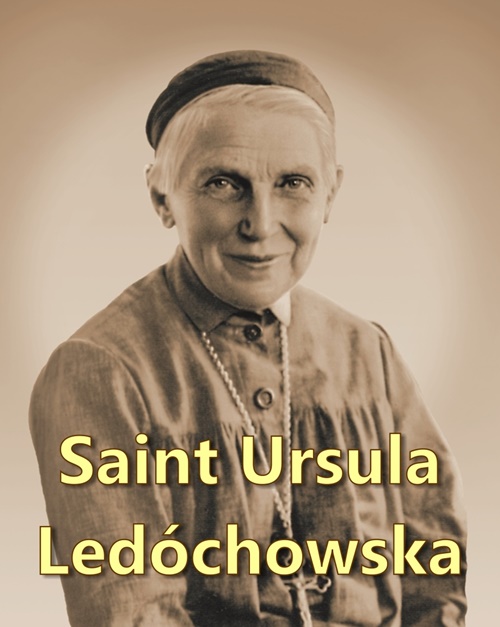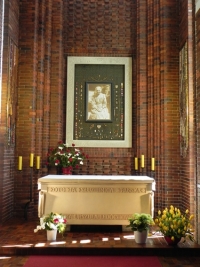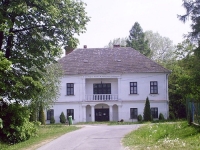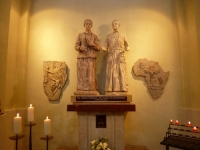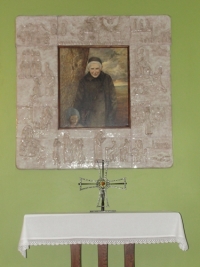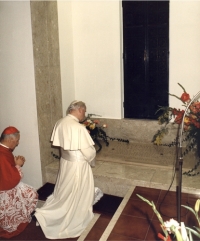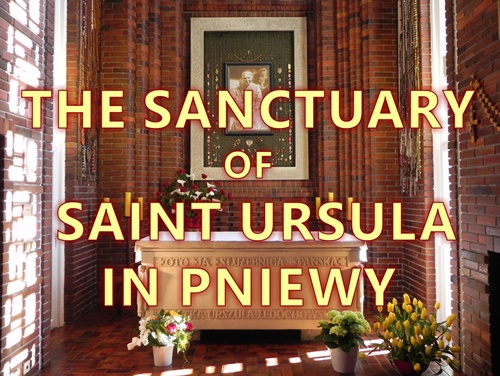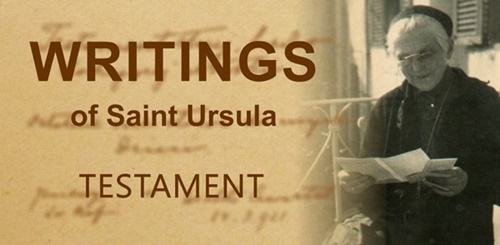
Places of devotion
The Sanctuary of St. Ursula in Pniewy
The Sanctuary of St. Ursula Ledóchowska is situated in Pniewy near the city of Poznań. Here, in 1920, the first house of the Ursuline Sisters of the Agonizing Heart of Jesus was founded upon mother Ursula’s return from Scandinavia. Therefore, this place is the motherhouse of the Grey Sisters. In 1989, the relics of the incorrupt body of mother Ursula were transferred from Rome to Pniewy, placed in a special reliquary and put in a sarcophagus in the chapel of the motherhouse.
The Sanctuary is a place of worship of St. Ursula and it is visited annually by around 10 thousand pilgrims from Poland and abroad. On December 9, 2003 the Sanctuary got the status of a diocesan sanctuary.
More information on www.sanktuarium-pniewy.pl/en/welcome/
Lipnica Murowana/ Poland
Lipnica Murowana, situated near Bochnia in Małopolska province, is a place associated with the youth of St. Ursula – Julia Ledóchowska. Her father, Antoni Ledóchowski, after living in Austria for many years wanted to return to Poland. In 1883 he acquired a manor house in Lipnica Murowana and moved there with his wife Józefina and their children – Maria Teresa, Julia, Franciszka and Ernestyna. Julia spent there three years of her life. Then, in August 1886, she left Lipnica and entered the Ursuline Order in Cracow.
In Lipnica one may visit the house of the Ursuline Sisters with the relic room from the manor house of the Ledóchowski family, which reminds about the presence of the family there.
More information on www.parlipnicam.tarnow.opoka.org.pl
Loosdorf/ Austria - place of birth
Loosdorf is a little town near Vienna (70 km west). Here, on April, 17 1865 St. Ursula – Julia Ledóchowska was born and spent her childhood. In 1874 the family moved to a nearby town, Sankt Pölten, where Julia along with her sisters attended the Institute of the English Ladies. The relics of St. Ursula and her older sister – blessed Maria Teresa can be found in a parochial church in Loosdorf. It is also possible to visit there a small museum devoted to life and mission of both sisters as well as their religious congregations – the Missionary Sisters of St. Peter Claver (the Claverians) and the Ursuline Sisters of the Agonizing Heart of Jesus (the Grey Ursulines).
The chapel of the Ursulines of the Roman Union in Cracow
In August 1886 Julia Ledóchowska entered the Ursuline Order in Cracow. On April 17, 1887 she got the Ursuline habit and received the name Maria Ursula. Two years later, on April 28, 1889 she took the solemn vows and began to work as a teacher and educator in school and boarding house of the Ursuline Convent. She also began to develop her painterly talent and in 1899 she decorated the convent chapel walls inside with paintings. In 1904 mother Ursula was elected the Mother Superior of the Convent and initiated the first in Poland hall of residence for young women studying at Jagiellonian University. In 1907, with the blessing of Pope Pius X, she went to Saint Petersburg accompanied by two sisters in order to administer St. Catherine’s Polish boarding high school for girls.
The relics of St. mother Ursula can be found in a chevet inside the chapel of the Ursulines of the Roman Union in Cracow.
Rome/ Italy - the chapel in the general house
The general house of the Congregation on via del Casaletto in Rome is one of the places particularly associated with St. Ursula, although it exists only from 1949 (from 1958 as the general house). During the process of beatification, in 1959, the body of mother Ursula was exhumed and it was stated that 20 years after her death the body did not decompose. Therefore, it was placed in a special sarcophagus and laid in the chapel of the general house on via del Casaletto. That is why, the chapel became a place of worship of mother Ursula, at that time, the servant of God. The chapel was also visited by dignified Church representatives such as cardinal priest Stefan Wyszyński, the Primate of Poland and cardinal priest Karol Wojtyła, also later as the Holy Father John Paul II. In 1989, after the next exhumation, the relics of (at that time) blessed mother Ursula were transferred from Rome to Pniewy, where they were placed in a special sarcophagus in the chapel at the motherhouse of the Congregation.





